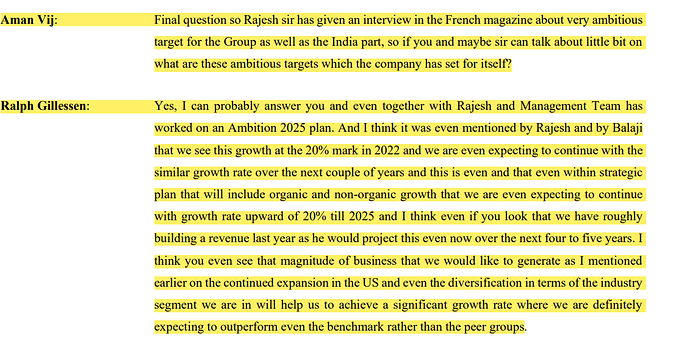(post deleted by author)
Posts tagged Value Pickr
Laurus Labs – Can Business Transform to Next Level? (28-07-2022)
Q1FY23 discussion on BQ.
Clean Science and Technology Limited (CSTL) – A clean and green future ahead (28-07-2022)
There is no doubt that new products will start with lower margins and improve over an year or two. The management had mentioned this in almost all the con calls. I was curious if sale of new products have already started in Q1 itself as the RM inflation was expected to increase higher in Q1 (Apr to Jun) due to Ukraine war and etc. Crude prices have started falling, so RM cost pressure should subside over the next few quarters, hence the important number that I am watching is topline and capex. As long as they are able to increase revenue regularly, they can get back to better margins (or absolute profits in worst case as long as revenue keeps increasing).
Competition is there for every company. So far they have done well and this is one area to keep watching regularly.
Laurus Labs: A much bigger journey ahead? (28-07-2022)
Q1 FY23
-
CDMO
-
Global Life Sciences company CDMO – qualification to happen in H2FY24. Multi year, multi product contract.
-
4 intermediates, 3 APIs – commercialized. Good number of late stage products.
-
-
FDF
-
EU formulation – some revenue in Q2, majority revenue in Q3 onwards
-
Civil infra can support 10bn additional capacity, only 5bn is installed now. FY24 – we can thinking of adding another 5bn.
-
-
ARV
- Except for South Africa, some of the country tenders went to winner takes it all. Roughly 10% tenders have become winner takes all category.
It looks like all the pricing, tender related risks are playing out in ARV segment.
EU Non-ARV product launches and Multi Product, Multi Year CDMO contract with dedicated facility are two interesting things happening.
Whether the CDMO revenue bump up is a one off or not would only be known in hindsight.
Disc – No investments
Clean Science and Technology Limited (CSTL) – A clean and green future ahead (28-07-2022)
As per Q3FY22 Concall the company has launched 2 new products TBHQ and PBQ in production(mentioned in presentation Q1FY23 as well). HAL’s production is expected from Q2FY23.
There was 4% increase in RM costs in Q1FY23. There could be 2 reasons i.e. product mix or Raw material cost increase. I remember Phenol being 50% of RM costs in Q4FY22 and Phenols price reduced by 7.4% in last 3 months
(source: tijorifinance)
so it must be other 50% of RM used to make other products. So my logical conclusion is product mix might have changed (as mentioned in slide No. 5 Q1FY23) in favour of TBHQ and PBQ, where they will have to offer discounts to increase market share.
Anyway I would like to hear from the Management itself.
CSTL increased MEHQ production by 50% for internal consumption to BHA. Vinati is a major customer for CSTL, and both being a world leader in their sector means both are interdependent. It is fair for Vinati to backward integrate to improve their margins but for CSTL it has to find buyers for their products to maintain their market leadership.
Great articles to read on the web (28-07-2022)
https://drive.google.com/file/d/1RBeTdGFjDlwBqWvt6nmLj52Qo-hJ1RMW/view
Hi guys I have always found this topic quite interesting. This is very useful if you credit cards. You will get to know as to why banks offer so many credit points on your transaction. The above link is about THE PAYMENT INDUSTARY ECOSYSTEM. Why I am posting this is because recently I read this article which beautifully explains how RUPAY is introducing MDR on transaction which they were not charging since their inception.
There is also a YouTube channel THINK SCHOOL(https://www.youtube.com/c/ThinkSchool/videos?view=0&sort=p&flow=grid). Extremely informative and beautiful explanation on various topic. If you want to develop good understanding on various topic I would highly recommend this channel.
I have gone through the above article but always had a few questions relating to them.
-
I have understood that the banks who issue rupay cards and have good amount of transaction will be benefiting but I have not been able to quantify it. Lets say a bank has 100cr worth transaction from repay credit card then what will be their CUT.
-
Will this also benefit banks who facilitate UPI transactions for Rupay credit cards regardless of they issuing the credit card. This question is on the assumption that a bank can facilitate UPI transaction on rupay credit card without being the issuer of that credit card. So please do correct me on my assumption.
Clean Science and Technology Limited (CSTL) – A clean and green future ahead (28-07-2022)
All said and done, one needs to tread cautiously when investing in companies that trade at such nose bleed valuations. This is an extremely unforgiving market and one average quarter or unfavorable news cycle (inflation, recession, RM price spike) is enough for a price beatdown citing unreasonable valuation of the stock.
Disc: currently not invested
NIIT Ltd (28-07-2022)
I have a question regarding the financials of 2017. There is a mismatch in FY17 figures in FY17 and FY18 annual reports. The revenue has been written down by approximately ₹ 350 crores and outsourcing expenses have also been written down. I can’t find the explanation in notes. Does anyone know the reason for this?


